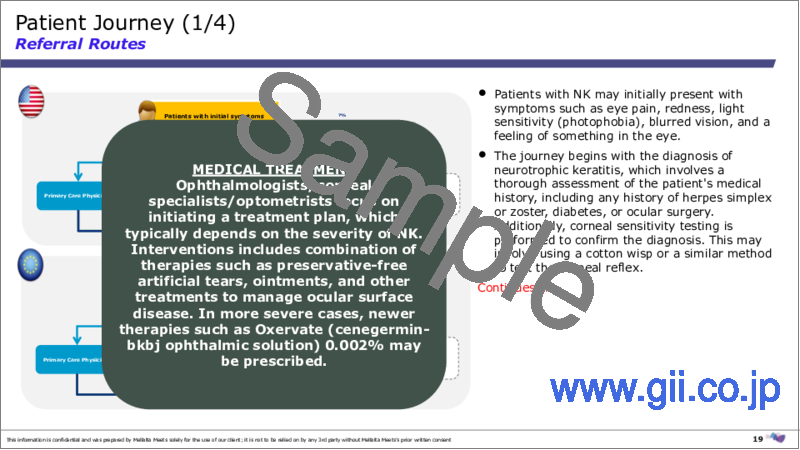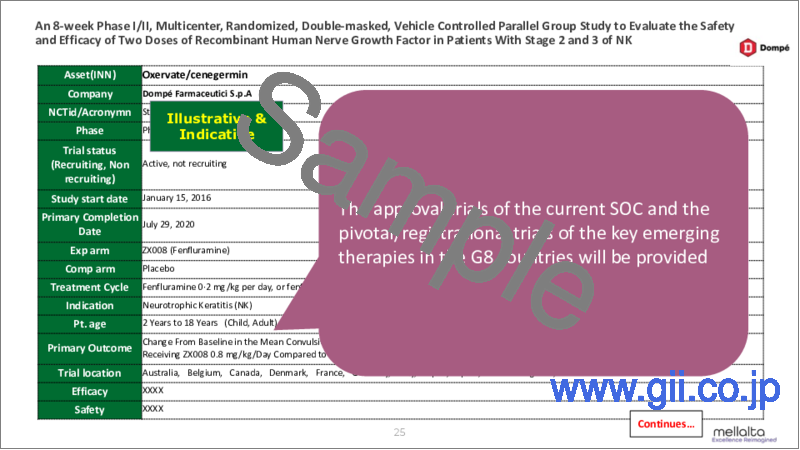|
|
市場調査レポート
商品コード
1466818
神経栄養性角膜炎(NK)市場:1次調査(KOLの洞察) - 市場インテリジェンス - 疫学と2034年までの市場予測Neurotrophic Keratitis (NK) | Primary Research (KOL's Insight) | Market Intelligence | Epidemiology & Market Forecast-2034 |
||||||
|
|||||||
| 神経栄養性角膜炎(NK)市場:1次調査(KOLの洞察) - 市場インテリジェンス - 疫学と2034年までの市場予測 |
|
出版日: 2024年02月21日
発行: Mellalta Meets LLP
ページ情報: 英文 180 Pages
納期: 即納可能
|
全表示
- 概要
- 目次
神経栄養性角膜炎(NK)市場は、最初に承認された唯一の治療薬であるOxervate/cenegerminや、防腐剤フリーの人工涙液、軟膏などの支持療法が大きく貢献しています。2034年までには、新規の新興治療薬の取り込みが、神経栄養性角膜炎(NK)治療薬市場に劇的な変化をもたらす大きなブレークポイントになると思われます。調査対象国(米国、フランス、ドイツ、イタリア、スペイン、英国、日本)における神経栄養角膜炎(NK)の市場規模は、2020年~2034年の調査期間中にCAGR 11%で高成長を遂げ、2034年までに24億米ドルとなると予測されています。
神経栄養角膜症としても知られる神経栄養角膜炎は、角膜感度の低下と角膜治癒不良を特徴とする変性疾患です。この疾患により角膜は傷害を受けやすくなり、反射性流涙が減少します。上皮の破壊は、潰瘍形成、感染、融解、および治癒不良による二次的な穿孔を引き起こす可能性があります。
神経栄養性角膜炎の患者は三叉神経に損傷を受ける。その結果、角膜の感覚が低下または欠如し、損傷の修復や角膜細胞の生存に重要な役割を果たす物質の産生が減少します。
神経栄養性角膜炎(NK)の診断は難しいですが、病気の進行を防ぐためには早期に発見することが重要です。NKの治療の主な目標は、上皮の完全性を保ち、上皮の治癒を促進し、角膜障害の進行を防ぐことです。これらの目標を達成するためには、早期診断、重症度に応じた治療、頻繁なモニタリングが重要です。NKの治療は、眼球潤滑のための潤滑点眼、超感染を予防するための局所抗生物質、治癒を促進し上皮の完全性を維持するための点眼薬やジェルなど、侵襲性の低い薬理学的選択肢から開始し、自然な形で順次行われることが多いです。難治性の症例や診断時に病勢が進行している症例では、より侵襲的で非薬理学的な治療が必要となります。これには、治療用コンタクトレンズ、羊膜移植(AMT)、霰粒腫切除術(永久的または一時的)、結膜フラップなどが含まれます。
当レポートでは、世界の神経栄養性角膜炎(NK)市場について調査し、市場の現状とともに、疾患の概要と治療法、患者動向、地域別の動向などを提供しています。
目次
第1章 エグゼクティブサマリー
第2章 神経栄養性角膜炎(NK)疾患の背景
- 神経栄養性角膜炎(NK)のイントロダクション
- 神経栄養性角膜炎(NK)の段階
- 兆候と症状
- 神経栄養性角膜炎(NK)の原因と危険因子
- 神経栄養性角膜炎(NK)の病因
第3章 神経栄養性角膜炎(NK)の診断
- 神経栄養性角膜炎(NK)の診断
第4章 疫学と患者集団
- 主な調査結果
- 方法とデータソース
- 国別の神経栄養性角膜炎(NK)の有病率
- 神経栄養性角膜炎(NK)の国別罹患率(病期別)
- 神経栄養性角膜炎(NK)の国別診断および治療症例
- 神経栄養性角膜炎(NK)疫学とモデルパラメータの主要な情報源
- 米国
- ドイツ
- フランス
- イタリア
- スペイン
- 英国
- 日本
第5章 現在の治療法と医療実践
- 神経栄養性角膜炎(NK)の治療と診療
- 神経栄養性角膜炎(NK)の角膜神経化
- 神経栄養性角膜炎(NK)の治療推奨事項
- 介入管理に関する専門家の意見
第6章 神経栄養性角膜炎(NK)患者動向
第7章 米国、EU4ヶ国、英国、日本におけるアンメットニーズ
第8章 上市済み治療法
- オキシルベート/セネゲルミン(Dompe Farmaceutici)
- カシコール/再生剤(Laboratoires Thea)
第9章 新たな治療法
- 主な調査結果
- パイプラインの概要
- 神経栄養性角膜炎(NK)分野における注目すべき進展
第10章 神経栄養性角膜炎(NK)の処方パターン
第11章 神経栄養性角膜炎(NK)- 価格と償還
- 神経栄養性角膜炎(NK)患者における資源利用と経済的影響
- Oxervateの価格設定と償還
第12章 将来の治療パラダイム
- 神経栄養性角膜炎(NK)の競合情勢と予想される承認
- 将来の治療アルゴリズムと競合のポジショニング
- 新たな治療法に関する主要データの概要
第13章 現行および新規治療の年間コスト
第14章 神経栄養性角膜炎(NK)における後期治療の戦略的考慮事項
第15章 市場見通し
- 主な調査結果
- 概要
- 2034年までの国別市場予測
第16章 国別市場予測
- 米国
- ドイツ
- フランス
- イタリア
- スペイン
- 英国
- 日本
第17章 市場促進要因と抑制要因
第18章 付録
The Neurotrophic Keratitis (NK) market is hugely contributed by the first and only approved therapy Oxervate/cenegermin and supportive treatments like preservative-free artificial tears, ointments and more. By 2034, the uptake of novel emerging therapies will serve as a major breakpoint to get a drastic change in the Neurotrophic Keratitis (NK) therapeutics market. The sales of the emerging therapies for the treatment Neurotrophic Keratitis (NK) in the study countries (United States, France, Germany, Italy, Spain, United Kingdom, and Japan) will experience high growth over the 2020-2034 study period, with 11% CAGR.
"One of the major obstacles in treating neurotrophic keratitis is once there is damage to the corneal nerves, there is impairment of those vital functions, which creates a significant disruption to the ocular surface. Most of these treatments are supportive and only stabilize the surface."
Neurotrophic keratitis, also known as neurotrophic keratopathy, is a degenerative disease characterized by decreased corneal sensitivity and poor corneal healing. This disorder leaves the cornea susceptible to injury and decreases reflex tearing. Epithelial breakdown can lead to ulceration, infection, melting, and perforation secondary to poor healing.
Patients with neurotrophic keratitis have damage to the trigeminal nerve. This results in reduced or lack of sensation in the cornea, and reduced production of the substances that play a vital role in repairing damage and ensuring survival of cornea cells.
Neurotrophic keratitis (NK) can be challenging to diagnose, but it is crucial to identify it early to prevent disease progression. The primary goals of treatment for NK are to preserve epithelial integrity, promote epithelial healing, and prevent the progression of corneal damage. Early diagnosis, severity-based treatment, and frequent monitoring are crucial for achieving these goals. The treatment of NK is often sequential in nature, starting with less invasive pharmacological options such as lubricant eye drops for eye lubrication, topical antibiotics to prevent super-infections, and eye drops or gels to promote healing and preserve epithelial integrity. In refractory cases or those with advanced disease at diagnosis, more invasive, non-pharmacological treatment alternatives may be required. These can include therapeutic contact lenses, amniotic membrane transplantation (AMT), tarsorrhaphy (permanent or temporary), or conjunctival flap.
Mellalta's Neurotrophic Keratitis (NK) Report- Market Summary
Market Size 2034: $2.4 billion
CAGR%: 11%
Key Market Players: RegeneRx Biopharmaceuticals/ReGenTree/HLB Therapeutics; BRIM Biotechnology; Recordati; Claris Biotherapeutics; Neuroptika
Forecast Period: 2020-2034
Countries Covered: US, France, Germany, Italy, Spain, UK, China, and Japan.
Current SOC: Nerve Growth Factor; Preservative free antibiotics; Artificial eye drops; Ointments; Surgical Interventions
Future SOC: NGF; HGF; Regenerative therapies
Key Unmet Need: Lack of restorative treatments for neurotrophic keratitis and early diagnosis; Variability in Clinical Practice
Key Insights: Approval of Cenegermin /Oxervate (Dompe) changed the treatment landscape by targeting underlying pathology with upto 72% patient achieving complete corneal healing at 8 weeks.
Provider-Patient (PPP) Perspective: Cost-effectiveness of treatment; Better Diagnostic Identification; Access to appropriate treatments and improved options
Mellalta's Neurotrophic Keratitis (NK) Report - Epidemiology
The total prevalent cases of Neurotrophic Keratitis (NK) in the G7 countries are anticipated to increase by a significant number of cases by 2034 for the study period (2020-2034). As per estimates, the United States will present with the highest prevalence of Neurotrophic Keratitis (NK) cases in 2034. Among the EU5, Germany had the highest Neurotrophic Keratitis (NK) cases, followed by France, Italy, Spain, and UK. Japan is reported to have the highest number of treated cases after the United States, Germany, France, and Italy.
Mellalta's Neurotrophic Keratitis (NK) Report - Current Market Size & Forecast Trends
The Neurotrophic Keratitis (NK) therapeutics market is expected to experience high growth throughout our study period (i.e., 2020 to 2034) with a CAGR of 11%. The United States captured the highest market share as compared to the European 5 countries and Japan.
The current standard of care is limited to therapies such as Artificial Tears, Autologous Serum Drops (SED), Corneal Neurotization/PK, and Amniotic Membrane Transplantation (AMT). Initial interventions advocate the cessation of corneal-sensitivity-reducing therapies, favoring instead preservative-free artificial tears and lubricant ointments. While the efficacy of topical corticosteroids in NK is debated due to potential adverse effects, emerging heparin sulfate biomimetic matrix regenerating agents offer promising prospects, demonstrating remarkable corneal healing and antiviral properties. The focus shifts to averting corneal ulcer development and promoting epithelial repair in NK Stage 2 and reduce corneal stromal scarring and prevent possible perforations in NK Stage 3.
Cenegermin, containing recombinant human nerve growth factor (rhNGF), marks a breakthrough, becoming the first FDA-approved drug for NK treatment in 2018. Clinical trials reveal its efficacy in promoting corneal healing, with patients exhibiting significant improvement compared to vehicle-treated counterparts. Moreover, its favorable safety profile underscores its potential as a cornerstone therapy. Apart from promoting corneal epithelial wound healing, cenegermin 20 µg/ml shows significant improvement in corneal sensitivity and in visual acuity with minor side effects. Moreover, findings suggest that cenegermin 20 µg/ml is also effective in pediatric patients.
In the 2024-2034 forecast period, there will be tremendous growth and shift in therapeutic market with the launch of novel emerging therapies like Timbetasin/RGN-259 (RegeneRx Biopharmaceuticals/ReGenTree/HLB Therapeutics), BRM424 (BRIM Biotechnology), REC 0/0559 (Recordati), CSB-001 (Claris Biotherapeutics), and NRO-1 (Neuroptika). The emerging therapies will likely compete with and replace existing treatments, reflecting a dynamic shift towards more advanced therapeutic options in the Neurotrophic Keratitis space and more.
Questions Answered
What is the size of clinically and commercially relevant drug-treatable Neurotrophic Keratitis (NK) populations, and how will drug-treatment rates change over time?
Potential challenges and opportunities in implementing approved therapy for Neurotrophic Keratitis (NK).
What are the most promising agents in the pipeline, and how will they shape the future of this therapy market?
What key drivers and constraints will affect the Neurotrophic Keratitis (NK) therapy market over the forecast period?
Report Highlights
Neurotrophic Keratitis (NK) - Current Market Trends
Neurotrophic Keratitis (NK) - Current & Forecasted Cases across the G7 Countries
Neurotrophic Keratitis (NK) - Market Opportunities and Sales Potential for Agents
Neurotrophic Keratitis (NK) - Patient-based Market Forecast to 2034
Neurotrophic Keratitis (NK) - Untapped Business Opportunities
Neurotrophic Keratitis (NK) - Product Positioning Vis-a-vis Competitors' Products
Neurotrophic Keratitis (NK) - KOLs Insight
Table of Content
1.Executive Summary
- 1.1.Key Findings
- 1.2.Key Market Challenges and Opportunities
- 1.3.What Do the Experts Say?
2.Neurotrophic Keratitis (NK) Disease Background
- 2.1.Neurotrophic Keratitis (NK) Introduction
- 2.2.Stages of Neurotrophic Keratitis (NK)
- 2.3.Sign & Symptoms
- 2.4.Causes and Risk factors of Neurotrophic Keratitis (NK)
- 2.5.Pathogenesis of Neurotrophic Keratitis (NK)
3.Neurotrophic Keratitis (NK) Diagnosis
- 3.1.Diagnosis of Neurotrophic Keratitis (NK)
4.Epidemiology and Patient Populations
- 4.1.Key Findings
- 4.2.Methods and data Sources
- 4.2.1.Country Specific Prevalent cases of Neurotrophic Keratitis (NK)
- 4.2.2.Country Specific Prevalent cases of Neurotrophic Keratitis (NK) by Stages
- 4.2.3.Country Specific Diagnosed and Treated cases of Neurotrophic Keratitis (NK)
- 4.3.Key Sources for Neurotrophic Keratitis (NK) Epidemiology and Model Parameters
- 4.3.1.United States
- 4.3.1.1.United States Prevalent cases of Neurotrophic Keratitis (NK)
- 4.3.1.2.United States Prevalent cases of Neurotrophic Keratitis (NK) by Stages
- 4.3.1.3.United States Diagnosed and Treated cases of Neurotrophic Keratitis (NK)
- 4.3.2.Germany
- 4.3.2.1.Germany Prevalent cases of Neurotrophic Keratitis (NK)
- 4.3.2.2.Germany Prevalent cases of Neurotrophic Keratitis (NK) by Stages
- 4.3.2.3.Germany Diagnosed and Treated cases of Neurotrophic Keratitis (NK)
- 4.3.3.France
- 4.3.3.1.France Prevalent cases of Neurotrophic Keratitis (NK)
- 4.3.3.2.France Prevalent cases of Neurotrophic Keratitis (NK) by Stages
- 4.3.3.3.France Diagnosed and Treated cases of Neurotrophic Keratitis (NK)
- 4.3.4.Italy
- 4.3.4.1.Italy Prevalent cases of Neurotrophic Keratitis (NK)
- 4.3.4.2.Italy Prevalent cases of Neurotrophic Keratitis (NK) by Stages
- 4.3.4.3.Italy Diagnosed and Treated cases of Neurotrophic Keratitis (NK)
- 4.3.5.Spain
- 4.3.5.1.Spain Prevalent cases of Neurotrophic Keratitis (NK)
- 4.3.5.2.Spain Prevalent cases of Neurotrophic Keratitis (NK) by Stages
- 4.3.5.3.Spain Diagnosed and Treated cases of Neurotrophic Keratitis (NK)
- 4.3.6.United Kingdom
- 4.3.6.1.United Kingdom Prevalent cases of Neurotrophic Keratitis (NK)
- 4.3.6.2.United Kingdom Prevalent cases of Neurotrophic Keratitis (NK) by Stages
- 4.3.6.3.United Kingdom Diagnosed and Treated cases of Neurotrophic Keratitis (NK)
- 4.3.7.Japan
- 4.3.7.1.Japan Prevalent cases of Neurotrophic Keratitis (NK)
- 4.3.7.2.Japan Prevalent cases of Neurotrophic Keratitis (NK) by Stages
- 4.3.7.3.Japan Diagnosed and Treated cases of Neurotrophic Keratitis (NK)
- 4.3.1.United States
5.Current Therapies and Medical Practice
- 5.1.Treatment and Medical Practices of Neurotrophic Keratitis (NK)
- 5.2.Corneal Neurotization in Neurotrophic Keratitis (NK)
- 5.3.Treatment Recommendations for Neurotrophic Keratitis (NK)
- 5.4.Expert Opinions on Interventional Management
6.Patient Journey in Neurotrophic Keratitis (NK)
- 6.1.Referral Routes
- 6.2.Diagnosis and Treatment Evaluation
- 6.3.Treatment Choice
7.Unmet Needs in US, EU4, UK, and JP
8.Marketed Therapies Chapters
- 8.1.Oxervate/cenegermin (Dompe Farmaceutici)
- 8.1.1.Product Profile
- 8.1.2.Clinical Development
- 8.1.3.Market & Sales Opportunity Forecasted to 2034
- 8.2.Cacicol/ReGeneraTing Agents (Laboratoires Thea)
- 8.2.1.Product Profile
- 8.2.2.Clinical Development
- 8.2.3.Market & Sales Opportunity Forecasted to 2034
9.Emerging Therapies
- 9.1.Key Findings
- 9.2.Pipeline Overview
- 9.3.Notable Developments in the Neurotrophic Keratitis (NK) space
- 9.3.1.Product Analysis
- 9.3.1.1.Timbetasin/RGN-259 (RegeneRx Biopharmaceuticals/ReGenTree/HLB Therapeutics)
- 9.3.1.1.1.Product Profile
- 9.3.1.1.2.Clinical Development
- 9.3.1.1.3.Market & Sales Opportunity Forecasted to 2034
- 9.3.1.2.BRM424 (BRIM Biotechnology)
- 9.3.1.2.1.Product Profile
- 9.3.1.2.2.Clinical Development
- 9.3.1.2.3.Market & Sales Opportunity Forecasted to 2034
- 9.3.1.3.REC 0/0559 (Recordati)
- 9.3.1.3.1.Product Profile
- 9.3.1.3.2.Clinical Development
- 9.3.1.3.3.Market & Sales Opportunity Forecasted to 2034
- 9.3.1.4.Varenicline (Oyster Point Pharma)
- 9.3.1.4.1.Product Profile
- 9.3.1.4.2.Clinical Development
- 9.3.1.4.3.Market & Sales Opportunity Forecasted to 2034
- 9.3.1.5.CSB-001 (Claris Biotherapeutics)
- 9.3.1.5.1.Product Profile
- 9.3.1.5.2.Clinical Development
- 9.3.1.5.3.Market & Sales Opportunity Forecasted to 2034
- 9.3.1.6.NRO-1 (Neuroptika)
- 9.3.1.6.1.Product Profile
- 9.3.1.6.2.Clinical Development
- 9.3.1.7.AP-001 (Anida Pharma)
- 9.3.1.7.1.Product Profile
- 9.3.1.8.OCS-05 (Oculis)
- 9.3.1.8.1.Product Profile
- 9.3.1.9.Undisclosed (Stuart Therapeutics)
- 9.3.1.9.1.Product Profile
- 9.3.1.10.MR-146 (Viatris)
- 9.3.1.10.1.Product Profile
- 9.3.1.11.Kuragenx (Pandorum Technologies)
- 9.3.1.11.1.Product Profile
- 9.3.1.12.Not Exhaustive list (more drugs are covered..)
- 9.3.1.1.Timbetasin/RGN-259 (RegeneRx Biopharmaceuticals/ReGenTree/HLB Therapeutics)
- 9.3.1.Product Analysis
10.Prescription Pattern in Neurotrophic Keratitis (NK)
- 10.1.Treatment pattern of Neurotrophic Keratitis (NK) in the United States
- 10.2.Treatment Efficacy and Utilization Patterns in patients with Neurotrophic Keratitis (NK) in France
- 10.3.Treatment Approaches in patients with Neurotrophic Keratitis (NK) in Italy
11.Neurotrophic Keratitis (NK) - Pricing & Reimbursement
- 11.1.Resource Utilization and Economic Impact in patients with Neurotrophic Keratitis (NK)
- 11.2.Oxervate Pricing and Reimbursement
12.Future Treatment Paradigm
- 12.1.Neurotrophic Keratitis (NK) Competitor Landscape and Approvals Anticipated
- 12.2.Future Treatment Algorithms and Competitor Positioning
- 12.3.Key Data Summary for Emerging Treatment
13.Annual Cost of Current & Emerging Treatment
14.Late Phase Therapies Strategic Considerations in Neurotrophic Keratitis (NK)
15.Market Outlook
- 15.1.Key Findings
- 15.2.Overview
- 15.3.Country Specific Market Forecast to 2034
- 15.3.1.Country Specific Market for Neurotrophic Keratitis (NK) 2019-2034 (USD Million)
- 15.3.2.Country Specific Market for Neurotrophic Keratitis (NK) by Therapies 2019-2034 (USD Million)
16.Market Forecast by Country
- 16.1.United States
- 16.1.1.United States Market for Neurotrophic Keratitis (NK) 2019-2034 (USD Million)
- 16.1.2.United States Market for Neurotrophic Keratitis (NK) by Therapies 2019-2034 (USD Million)
- 16.2.Germany
- 16.2.1.Germany Market for Neurotrophic Keratitis (NK) 2019-2034 (USD Million)
- 16.2.2.Germany Market for Neurotrophic Keratitis (NK) by Therapies 2019-2034 (USD Million)
- 16.3.France
- 16.3.1.France Market for Neurotrophic Keratitis (NK) 2019-2034 (USD Million)
- 16.3.2.France Market for Neurotrophic Keratitis (NK) by Therapies 2019-2034 (USD Million)
- 16.4.Italy
- 16.4.1.Italy Market for Neurotrophic Keratitis (NK) 2019-2034 (USD Million)
- 16.4.2.Italy Market for Neurotrophic Keratitis (NK) by Therapies 2019-2034 (USD Million)
- 16.5.Spain
- 16.5.1.Spain Market for Neurotrophic Keratitis (NK) 2019-2034 (USD Million)
- 16.5.2.Spain Market for Neurotrophic Keratitis (NK) by Therapies 2019-2034 (USD Million)
- 16.6.United Kingdom
- 16.6.1.United Kingdom Market for Neurotrophic Keratitis (NK) 2019-2034 (USD Million)
- 16.6.2.United Kingdom Market for Neurotrophic Keratitis (NK) by Therapies 2019-2034 (USD Million)
- 16.7.Japan
- 16.7.1.Japan Market for Neurotrophic Keratitis (NK) 2019-2034 (USD Million)
- 16.7.2.Japan Market for Neurotrophic Keratitis (NK) by Therapies 2019-2034 (USD Million)
17.Market Drivers and Constraints
- 17.1.1.What Factors Are Driving the Market for Neurotrophic Keratitis (NK)?
- 17.1.2.What Factors Are Constraining the Market for Neurotrophic Keratitis (NK)?
18.Appendix
- 18.1.Methodology






